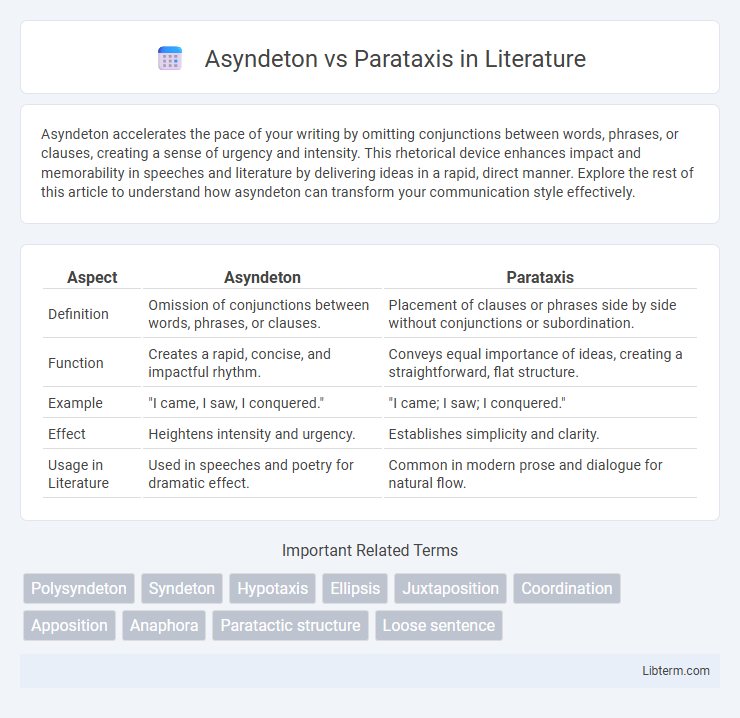Asyndeton accelerates the pace of your writing by omitting conjunctions between words, phrases, or clauses, creating a sense of urgency and intensity. This rhetorical device enhances impact and memorability in speeches and literature by delivering ideas in a rapid, direct manner. Explore the rest of this article to understand how asyndeton can transform your communication style effectively.
Table of Comparison
| Aspect | Asyndeton | Parataxis |
|---|---|---|
| Definition | Omission of conjunctions between words, phrases, or clauses. | Placement of clauses or phrases side by side without conjunctions or subordination. |
| Function | Creates a rapid, concise, and impactful rhythm. | Conveys equal importance of ideas, creating a straightforward, flat structure. |
| Example | "I came, I saw, I conquered." | "I came; I saw; I conquered." |
| Effect | Heightens intensity and urgency. | Establishes simplicity and clarity. |
| Usage in Literature | Used in speeches and poetry for dramatic effect. | Common in modern prose and dialogue for natural flow. |
Introduction to Asyndeton and Parataxis
Asyndeton is a rhetorical device that omits conjunctions between words, phrases, or clauses to create a concise, impactful effect, often enhancing rhythm and urgency. Parataxis involves placing clauses or phrases side by side without explicit conjunctions or subordinating elements, fostering simplicity and directness in sentence construction. Both techniques manipulate sentence structure to influence the flow and emphasis of ideas, with asyndeton focusing on omission for stylistic intensity and parataxis on juxtaposition for clarity and straightforwardness.
Defining Asyndeton: Meaning and Usage
Asyndeton is a rhetorical device characterized by the deliberate omission of conjunctions between phrases or clauses to create a concise and impactful sentence structure. This technique enhances the rhythm and intensity of the text by accelerating the pace and emphasizing the listed elements. Commonly used in speeches, literature, and advertising, asyndeton effectively draws attention and conveys urgency or strong emotion.
What is Parataxis? Key Characteristics
Parataxis is a literary and rhetorical technique characterized by placing clauses or phrases one after another without using coordinating or subordinating conjunctions. This style creates a concise, direct, and sometimes fragmented effect, emphasizing the equality and simplicity of ideas. Often found in classical texts and everyday speech, parataxis allows for rapid, impactful delivery by relying on juxtaposition rather than explicit logical connections.
Historical Origins of Asyndeton and Parataxis
Asyndeton, originating from ancient Greek rhetoric, was a stylistic device used by classical orators like Demosthenes to create rapid, impactful speech by omitting conjunctions. Parataxis, rooted in early Greek literature and famously utilized by Homer, involves placing clauses or phrases side by side without subordinating conjunctions, focusing on equal importance and straightforward presentation. Both techniques reflect early linguistic strategies to enhance persuasion and narrative clarity in classical texts.
Structural Differences Between Asyndeton and Parataxis
Asyndeton presents a structure where coordinating conjunctions are deliberately omitted between clauses or phrases to create a concise and impactful effect. Parataxis involves placing clauses or phrases side by side without subordinating conjunctions, often connected by coordinating conjunctions or punctuation, emphasizing equal importance among elements. The primary structural difference lies in asyndeton's intentional omission of conjunctions for brevity, whereas parataxis arranges multiple syntactic units in coordination or juxtaposition, frequently using conjunctions or punctuation marks.
Effects on Tone and Rhythm
Asyndeton creates a rapid, intense tone by omitting conjunctions, resulting in a fast-paced, urgent rhythm that emphasizes each element individually. Parataxis presents clauses or phrases side by side without subordination, producing a straightforward, balanced tone with a rhythmic, conversational flow. The use of asyndeton often accelerates the tempo and heightens emotional impact, whereas parataxis fosters clarity and simplicity, shaping a more measured and deliberate cadence.
Examples of Asyndeton in Literature
Asyndeton is a literary device characterized by the omission of conjunctions between phrases or clauses, creating a concise and impactful effect. Famous examples include Julius Caesar's speech in Shakespeare's *Julius Caesar*: "I came, I saw, I conquered," which emphasizes speed and decisiveness. Another example is Ernest Hemingway's concise sentence in *A Farewell to Arms*: "We went to the mountains, to the sea, to the hills," showcasing rapid succession of actions without conjunctions.
Examples of Parataxis in Literature
Parataxis in literature features simple, short sentences or phrases placed side by side without coordinating conjunctions, creating a rapid, rhythmic effect. Famous examples include Ernest Hemingway's "He was an old man who fished alone in a skiff in the Gulf Stream and he had gone eighty-four days now without taking a fish," showcasing straightforward clauses linked without conjunctions. Similarly, in Samuel Beckett's "Waiting for Godot," dialogue employs paratactic structures like "They give birth astride of a grave, the light gleams an instant, then it's night once more," emphasizing existential tension through stacked statements.
When to Use Asyndeton vs. Parataxis
Asyndeton and parataxis both enhance sentence rhythm and emphasis, but asyndeton omits conjunctions to create a fast-paced, dramatic effect, ideal for speeches or persuasive writing. Parataxis uses simple, coordinate clauses without subordinating conjunctions, making it suitable for straightforward, clear statements or narrative sequences. Choose asyndeton when you want to intensify urgency or emotion, while parataxis works best to present facts or actions in a balanced, equal manner.
Impact on Reader Interpretation and Style
Asyndeton, characterized by the omission of conjunctions between phrases or clauses, creates a rapid, impactful rhythm that enhances emotional intensity and urgency, compelling readers to process ideas more swiftly. Parataxis, involving the placement of clauses or phrases side by side without subordinating conjunctions, fosters simplicity and directness, allowing readers to interpret each element with equal importance and draw their own connections. The stylistic choice between asyndeton and parataxis significantly influences reader engagement, with asyndeton driving a dynamic, forceful tone and parataxis offering clarity and openness in narrative flow.
Asyndeton Infographic

 libterm.com
libterm.com